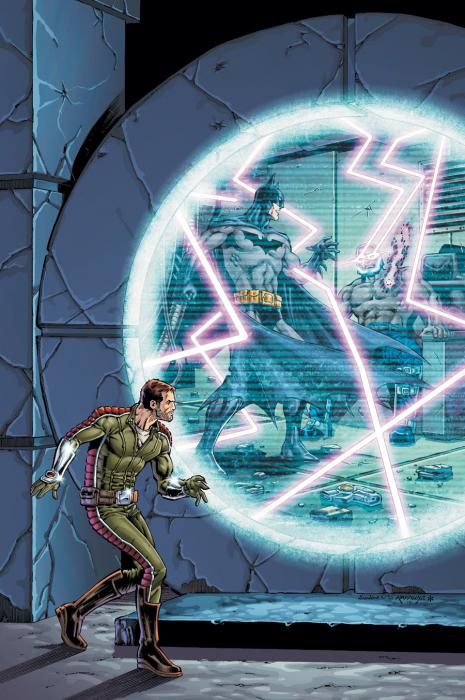"I thought they were holding the line at $2.99," my local comic shop guy said as he rang me up for this issue with its $3.99 pricepoint.
"They started this one at $3.99 and held that all the way through," was my reply. This series also maintained a high production value, with the heavier cover stock and consistent creative crew from start to finish. Inside the covers, however, the story had starts and stops, detours, and the alternate routes that frequently accompany those detours.
This issue officially ends the search for Batman, by explaining just how it was that the goal the quintet of Superman, Green Lantern, Booster Gold, Rip Hunter, and Skeets set out with never really crystallized. I can certainly see where that might spark some inflammatory remarks, but those reading this book were most likely on board for more than just a Batman cameo.
The five issues up to this point bounced around time a bit, visiting some characters that were possibly forgotten while possibly forgetting what it set out to do. Branded as a piece of the return of Batman upon its initial release, this series outlasted the return and stretched on longer, effectively spanning a couple events for DC and setting up the next big storyline. And that is where this issue leaves off. Without spoiling a darn thing, I think it is safe to say that there is a substantial amount of hullabaloo centered around the return of Rip Hunter's chalkboards, and this issue sure packs quite a few titillating surprises there. The end of this issue leads into "Booster Gold" #44 and "Flashpoint" #1, and if you're looking for spoilers, I'm sure you can find them elsewhere.
Jurgens' art is rock solid all the way through this issue, as it has been in the series to this point. It helps, I'm sure, that Jurgens is writing (to a point) to his interests and strengths, but the end result is still a book that looks as nice as it reads. The over-the-top bright coloring from Hi-Fi fits this segment of Booster Gold's world quite nicely.
This title was saddled with a "Search for Batman" subhead and brought along Superman and Green Lantern, all obviously to raise awareness for the book, so if the "surprise" chalkboards get missed, well, DC tried to lure readers in without smacking them over the head with a story-spoiling solicit months in advance. After all, fans complain about a lack of surprises in the books they read, well, you got some surprises now.
Not quite a surprise in his appearance here, but more surprising from here, Zoom buzzes by, shifting through time unaided and unimpeded, searching for Omega energy that appears to put him on a path parallel to the one the heroes are on. Conversely, Black Beetle is here (even if he is more red than black) getting in the way of the heroes and serving as a persistent nemesis for Booster and Rip. This issue even holds the creation of a new character and the return of Supernova.
All in all, this series was entertaining, and served as a nice companion piece to "Booster Gold," but it seemed to lack the beef the story could have had in the pages of "Booster Gold" instead of being a freestanding title of its own right. I appreciated Jurgens' investigations of some abstruse concepts from across the DC Universe as well as his continued (and tragically underappreciated) ability to deliver all ages appropriate stories. My kids won't necessarily appreciate the physics behind time travel, but they sure enjoy a good story that has good guys and bad guys, and Jurgens definitely delivers that here.
As mentioned previously, this issue points directly to "Flashpoint," and is certain to gain a little buzz in circles of readers anticipating the next big DC event. I'm fairly certain that the chalkboards won't be the only element to be revisited therein.

